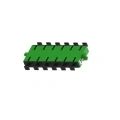Exploring the Physical Characteristics and Function of Fiber Optic Adapters

A fiber optic adapter plays a crucial role in connecting two fiber optic cables together seamlessly. It is a small device designed to enable a secure and reliable connection between the connectors on the end of two fiber optic cables. The appearance of a fiber optic adapter is vital in ensuring efficient data transmission in various telecommunication and networking applications.
1. Physical Characteristics
A fiber optic adapter typically has a rectangular shape and is made from durable plastic or metal materials. Its compact size allows it to fit into a variety of equipment and systems easily. On the exterior, the adapter may have one or two slots or holes where the connectors from the fiber optic cables are inserted. These slots or holes are usually aligned vertically or horizontally. Adapters can have various designs, including simplex, duplex, or quad configurations, to accommodate different cable connection requirements.
The interior of a fiber optic adapter contains precision alignment sleeves or ferrules. These components ensure precise and accurate alignment of the fiber optic connectors, minimizing signal loss and maximizing light transmission efficiency. The alignment sleeves are typically made of ceramic or metal such as zirconia, providing excellent durability and resistance to wear and tear.
2. Connector Types
Fiber optic adapters come in various connector types, including but not limited to SC, LC, ST, FC, and MTRJ. Each connector type has distinct characteristics and usage scenarios. For example, the SC connector is rectangular and uses a push-pull mechanism, while the LC connector is small and uses a latch mechanism. The choice of adapter connector type depends on the specific fiber optic cables and equipment being used.
It is worth noting that fiber optic adapters can also be categorized based on their mode types, such as single-mode or multimode. Single-mode adapters are used for long-distance transmission, while multimode adapters are suitable for short-distance communications.
3. Common Applications
Fiber optic adapters are widely used in various industries and applications. They are commonly employed in telecommunications networks, data centers, cable TV installations, and computer networking systems. These adapters provide the flexibility to connect different fiber optic connectors, allowing for easy expansion, modifications, or repairs in existing fiber optic infrastructures.
Moreover, fiber optic adapters find extensive use in fiber optic testing and measurement equipment. In testing environments, adapters are used to connect fiber optic cables to measurement instruments, ensuring accurate and reliable test results.
In summary, a fiber optic adapter is a compact yet crucial component in fiber optic systems. It facilitates seamless connections between fiber optic cables, ensuring efficient data transmission. With their different physical characteristics, connector types, and applications, fiber optic adapters enable the seamless integration and operation of fiber optic networks across various industries.



